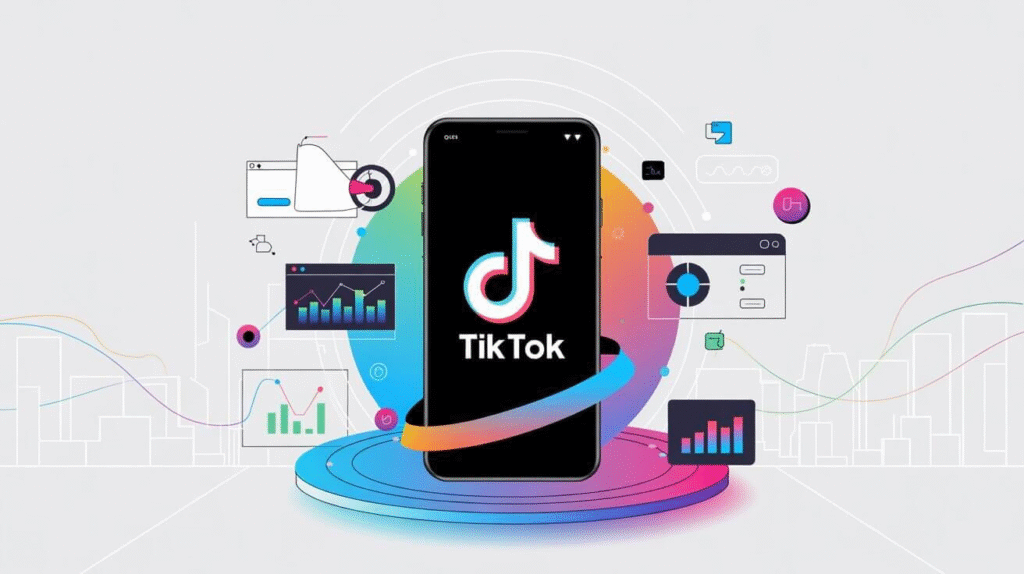Is TikTok Worth It in 2025? An Honest, Data-Driven Review
Have you been wondering if TikTok is still worth your time in 2025? You’re not alone. With over 2.1 billion users worldwide and counting, TikTok continues to dominate the social media landscape. But is it really worth investing your precious time, energy, and resources into this platform?

I’ve spent countless hours researching the latest TikTok statistics, interviewing creators, and analyzing the platform’s evolution to bring you this comprehensive, no-nonsense guide. Whether you’re a content creator looking to build an audience, a business owner considering TikTok marketing, or just curious about the platform’s value in 2025, this article has you covered.
TikTok has transformed dramatically since its global launch. What started as a lip-syncing app has evolved into a cultural powerhouse that influences everything from music and fashion to politics and education. But with rising competition from YouTube Shorts and Instagram Reels, plus ongoing regulatory challenges, TikTok’s position isn’t as secure as it once was.
In this honest review, we’ll dive deep into TikTok’s current state in 2025. I’ll share real statistics, practical insights, and actionable advice to help you decide if TikTok deserves a place in your social media strategy. Let’s cut through the hype and get to the facts.
TikTok in 2025: By the Numbers
Let’s start with the cold, hard facts. TikTok’s growth continues to impress industry analysts, though it’s no longer the explosive phenomenon it once was.
As of 2025, TikTok boasts 1.58 billion monthly active users worldwide. This places it as the fifth most popular social media platform globally, behind Facebook (3.065 billion), YouTube (2.5 billion), WhatsApp (2 billion), and Instagram (2 billion).
The United States remains TikTok’s largest market outside of China, with 135 million users. This represents significant growth from previous years, despite ongoing regulatory concerns.
When it comes to demographics, TikTok’s user base has matured. While it was once dominated by teens and young adults, the platform now attracts a broader age range:
- 25-34 years: 30% (largest age group)
- 18-24 years: 25%
- 35-44 years: 19%
- 45-54 years: 13%
- 55+ years: 14%
This shift reflects TikTok’s evolution from a teen-focused app to a mainstream social media platform. In fact, 55% of TikTok users are now under 30 years old, showing the platform has successfully retained its younger audience while expanding to older demographics.
What’s particularly impressive is how much time users spend on TikTok. The average user spends 25.5 hours per month on the platform – that’s nearly a full day each month scrolling through short videos. This outpaces YouTube (23.7 hours), Facebook (19.6 hours), and Instagram (11.2 hours).
TikTok’s engagement rate also remains industry-leading at 2.34%, compared to YouTube Shorts at 0.91% and Instagram Reels at approximately 1.2%. This means TikTok users are more likely to like, comment, and share content than users on other platforms.
The platform’s content volume is staggering. About 16,000 videos are uploaded to TikTok every minute – that’s 960,000 per hour and over 23 million per day. This creates both opportunities and challenges for creators trying to stand out.
The TikTok Algorithm in 2025
TikTok’s algorithm remains its secret weapon, though it’s evolved significantly since the platform’s early days. Understanding how it works in 2025 is crucial to determining if the platform is worth your time.
How the Algorithm Has Changed
The core of TikTok’s recommendation system still revolves around the For You Page (FYP), which serves personalized content based on user behavior. However, TikTok has made several key changes to improve content quality and creator satisfaction.
First, watch time now carries more weight than completion rate. This means longer videos (1-3 minutes) can perform well even if viewers don’t watch until the end. This change aligns with TikTok’s push for longer-form content to compete with YouTube Shorts.
Second, comment quality now impacts reach more than quantity. The algorithm prioritizes videos that generate thoughtful, lengthy comments over those with numerous short responses. This encourages creators to produce content that sparks genuine conversation.
Third, TikTok has improved its topic classification system. The algorithm now better understands niche content, helping creators reach highly targeted audiences interested in specific subjects. This is especially valuable for businesses and specialized content creators.
What Content Performs Best in 2025
The algorithm now factors in content freshness more heavily. Newer trends and formats often receive a temporary boost in visibility, encouraging creators to stay current with platform trends.
Finally, TikTok has implemented more sophisticated spam and low-quality content filters. This means authentic, original content has a better chance of reaching audiences than repurposed or unoriginal videos.
For new creators, the algorithm still offers a relatively level playing field compared to other platforms. TikTok continues to test content from creators of all sizes, giving smaller accounts the opportunity to reach large audiences if their content resonates.
However, consistency has become increasingly important. The algorithm now favors accounts that post regularly (3-5 times per week) over those with sporadic activity. This represents a shift from TikTok’s earlier days when viral one-hit wonders were more common.
Monetization Opportunities on TikTok
One of the most important factors in determining if TikTok is worth it in 2025 is monetization potential. How much can creators actually earn on the platform?
Creator Rewards Program Explained
The biggest change in recent years has been the transition from the Creator Fund to the Creator Rewards Program. This new system offers significantly better compensation for creators, with earnings typically ranging from $0.40 to $1.00 per 1,000 views. Some creators with highly engaged audiences report earning up to $10 per 1,000 views.
This is a substantial improvement from the old Creator Fund, which paid a meager $0.02 to $0.04 per 1,000 views. However, it still falls short of YouTube’s ad revenue sharing model, which can pay creators $2 to $5 per 1,000 views.
To qualify for the Creator Rewards Program, you need:
- At least 10,000 followers
- 100,000+ video views in the past 30 days
- To be at least 18 years old
- An account in good standing
- To reside in a supported region
Only videos that are at least one minute long and reach 1,000 valid views on the For You page can earn rewards. This minimum length requirement has pushed many creators toward longer-form content.
Beyond the Creator Rewards Program
Beyond the Creator Rewards Program, TikTok offers several other monetization avenues:
TikTok Shop has expanded significantly, allowing creators to earn commissions by promoting products directly within the app. Commission rates typically range from 5% to 20% depending on the product category.
LIVE Gifts remain popular, with viewers purchasing virtual gifts that can be converted to real money. Top livestreamers report earning $200-$500 per hour during peak sessions.
Brand partnerships have matured on the platform, with established TikTok creators commanding $1,000 to $10,000 per sponsored post, depending on follower count and engagement rate.
The Creator Marketplace has become more sophisticated, making it easier for brands to find and collaborate with suitable creators. This has opened doors for mid-sized creators who previously struggled to secure partnerships.
TikTok Premium Subscriptions, introduced in late 2024, allow creators to offer exclusive content to paying subscribers. While still in its early stages, this feature provides another revenue stream for established creators.
It’s worth noting that monetization success varies dramatically based on niche, content quality, and audience engagement. Finance, business, and educational content typically earn higher rates than entertainment or lifestyle content.
TikTok for Personal Branding
Building a personal brand on TikTok in 2025 requires a different approach than in previous years. The platform has matured, and so have strategies for standing out.
Success Stories and Case Studies
The good news is that TikTok still offers unparalleled organic reach compared to other social platforms. While Facebook and Instagram have become increasingly pay-to-play, TikTok continues to surface content from creators of all sizes based primarily on quality and engagement.
Personal branding success stories abound. Take Mia Thompson, a financial advisor who grew from zero to 500,000 followers in just eight months by sharing bite-sized financial tips. Or Marcus Chen, a home chef who parlayed his TikTok following into a cookbook deal and product line.
Time Investment vs. Results
However, the time investment required to build a successful personal brand on TikTok shouldn’t be underestimated. Most successful creators spend between 10-15 hours per week on content creation alone.
Weekly Time Investment for TikTok Content Creation
This breaks down to:
- Research and planning: 1-2 hours
- Filming: 2-3 hours
- Editing: 3-4 hours
- Engagement and community management: 2-3 hours
- Analytics and strategy adjustment: 1-2 hours
Strategies That Work in 2025
The most successful personal brands on TikTok in 2025 share several characteristics:
Consistency in posting schedule – They maintain a regular cadence, typically posting 3-5 times per week.
Niche focus – Rather than trying to appeal to everyone, they target specific interests or solve particular problems.
Authentic personality – They showcase genuine personality traits rather than adopting personas.
Value-first approach – They prioritize providing value (education, entertainment, inspiration) over self-promotion.
Trend adaptation – They participate in trends but adapt them to fit their niche and brand voice.
Cross-platform strategy – They use TikTok as a discovery tool but often direct followers to other platforms (like Instagram or YouTube) for deeper engagement.
The potential pitfalls include burnout from the constant demand for content, algorithm changes that can dramatically affect reach, and the challenge of monetizing followers effectively.
For personal branding, TikTok is particularly worth it if you’re in a visual or performance-based field, targeting younger demographics, or have a teaching/educational component to your brand. It’s less effective for highly technical B2B services or luxury products targeting older demographics.
TikTok for Business Marketing
For businesses, TikTok’s value proposition in 2025 is compelling but comes with important caveats.
ROI Statistics for Businesses
The platform’s advertising ecosystem has matured significantly, offering sophisticated targeting options and diverse ad formats. TikTok’s ad revenue reached $23.3 billion in 2024, with projections of $34.8 billion by 2026.
What’s particularly noteworthy is that 51% of small businesses advertising on TikTok report a positive ROI. This is impressive for a platform once considered experimental for business marketing.
Advertising Options and Costs
TikTok offers several advertising options:
In-Feed Ads appear in users’ For You feeds and now include interactive elements like polls and quizzes. Average cost-per-click (CPC) ranges from $0.50 to $1.00, while cost-per-thousand-impressions (CPM) typically falls between $8 and $10.
TopView Ads appear when users first open the app, guaranteeing maximum visibility. These premium placements cost $50,000 to $150,000 depending on targeting options.
Branded Hashtag Challenges encourage user participation and content creation around a branded theme. These start at $150,000 but can generate massive engagement when executed well.
Branded Effects allow users to interact with AR filters and effects created by brands. These typically cost $25,000 to $50,000 to develop and promote.
TikTok Shop Ads promote products available for purchase directly within the app. These performance-based ads typically operate on a cost-per-acquisition model ranging from $5 to $20 depending on the product category.
Organic vs. Paid Reach
Beyond paid advertising, organic business content can still perform exceptionally well on TikTok. Brands like Duolingo, Ryanair, and Chipotle have built massive followings through creative, entertaining content that doesn’t feel like traditional marketing.
The businesses seeing the best results on TikTok in 2025 share these characteristics:
Authenticity over production value – Content that feels genuine and unpolished often outperforms highly produced videos.
Creator partnerships – Collaborating with established TikTok creators typically yields better results than branded content alone. Ads using TikTok creators see a 26% increase in brand favorability.
Educational content – “How-to” videos and useful tips related to products or services perform exceptionally well.
Behind-the-scenes glimpses – Content showing the human side of businesses consistently engages users.
Quick adaptation to trends – Businesses that can rapidly incorporate trending sounds, formats, or challenges see better results.
Industries seeing the strongest ROI on TikTok include fashion, beauty, food and beverage, entertainment, fitness, and direct-to-consumer products. B2B companies and financial services firms typically face more challenges but can succeed with creative approaches.
TikTok vs. Competitors in 2025
To truly determine if TikTok is worth it in 2025, we need to compare it to its main competitors: Instagram Reels and YouTube Shorts.
Market Share and Platform Dominance
TikTok maintains a dominant position in the short-form video market with approximately 40% market share, compared to 20% each for YouTube Shorts and Instagram Reels.
When comparing the platforms, several key differences emerge:
Content Discovery and Reach
TikTok still offers the best opportunity for new creators to reach large audiences quickly. Its algorithm remains more willing to promote content from accounts with small followings if engagement metrics are strong.
Instagram Reels favors creators who already have established Instagram followings, making it harder for newcomers to break through. However, Reels offers better integration with the broader Instagram ecosystem.
YouTube Shorts has improved its discovery mechanisms but still tends to promote content from channels with existing subscriber bases. That said, Shorts offers the best pathway to long-form content, allowing creators to convert short-form viewers into subscribers who watch longer videos.
Monetization Comparison
YouTube Shorts offers the most robust monetization through its Partner Program, which shares ad revenue with creators. This typically results in higher earnings per view than TikTok’s Creator Rewards Program.
TikTok’s Creator Rewards Program offers improved payouts compared to previous years but still lags behind YouTube in terms of revenue per view. However, TikTok Shop provides strong e-commerce opportunities that YouTube lacks.
Instagram Reels has the weakest direct monetization options but offers excellent opportunities for brand partnerships and product promotions, especially for lifestyle and fashion content.
Content Longevity and Audience Engagement
YouTube Shorts content has the longest shelf life, often continuing to receive views months after posting. This creates more sustainable growth for creators.
TikTok videos typically have a shorter lifespan, with most views occurring within the first 48 hours after posting. However, videos can resurge if they get picked up by the algorithm again.
Instagram Reels falls somewhere in between, with content typically remaining relevant for about a week before engagement drops significantly.
TikTok maintains the highest engagement rate at 2.34%, compared to YouTube Shorts at 0.91% and Instagram Reels at approximately 1.2%.
However, YouTube Shorts viewers are more likely to subscribe to channels and watch longer content, potentially creating more valuable long-term relationships.
Instagram Reels benefits from integration with Instagram’s robust messaging features, facilitating more direct communication between creators and audiences.
The platform comparison reveals that TikTok remains the strongest option for rapid audience building and viral potential, while YouTube Shorts offers better long-term monetization, and Instagram Reels provides the best integration with a broader social media presence.
The Time Investment Reality
One of the most important factors in determining if TikTok is worth it is understanding the time commitment required for success. This is where many creators and businesses underestimate what’s needed.
Weekly Time Requirements Breakdown
Creating quality TikTok content in 2025 requires a significant time investment. Successful creators typically spend 9-14 hours per week on TikTok-related activities:
- Research and trend monitoring: 1-2 hours weekly
- Content planning: 1-2 hours weekly
- Filming: 2-3 hours weekly
- Editing: 3-4 hours weekly
- Engaging with followers: 2-3 hours weekly
This doesn’t include time spent analyzing performance metrics and adjusting strategy, which can add another 1-2 hours weekly.
For businesses, the time investment is often even higher when factoring in strategy meetings, approval processes, and coordination between team members. Many businesses underestimate this commitment, leading to abandoned TikTok accounts or inconsistent posting.
Posting Frequency for Optimal Results
The frequency of posting also matters significantly. The algorithm in 2025 favors accounts that post consistently, with 3-5 posts per week being the sweet spot for most creators. This represents an increase from previous years when 2-3 posts weekly was often sufficient.
Tools to Streamline the Process
Several tools can help streamline the TikTok content creation process:
CapCut has evolved into a comprehensive editing suite with templates specifically designed for TikTok.
TrendTok helps identify emerging trends before they peak, giving creators a head start.
Hashtag Expert provides data-driven hashtag recommendations to maximize discoverability.
TikAnalytics offers deeper insights into performance metrics than TikTok’s native analytics.
ContentCal allows teams to plan and schedule content collaboratively.
Despite these tools, the reality is that TikTok success requires a consistent time commitment that many individuals and businesses struggle to maintain. This is especially true given that TikTok’s algorithm changes frequently, requiring creators to constantly adapt their strategies.
When considering if TikTok is worth it, honestly assess whether you can commit the necessary time on an ongoing basis. Sporadic posting or half-hearted efforts rarely yield meaningful results on the platform in 2025.
Privacy and Security Considerations
Any honest assessment of TikTok in 2025 must address the ongoing privacy and security concerns surrounding the platform.
Current Privacy Concerns
TikTok continues to face scrutiny over its data collection practices and potential ties to the Chinese government through its parent company, ByteDance. While TikTok has implemented measures like storing U.S. user data on Oracle servers located in the United States (Project Texas), concerns persist.
The platform collects extensive user data, including:
- Device information (including location, IP address, and unique identifiers)
- Usage information (including viewing habits and interaction patterns)
- Content information (including videos created, even if not posted)
- Messages sent through the platform
- Information from third-party social media accounts if linked
This data collection is more extensive than many other social platforms, raising legitimate privacy concerns for users.
Regulatory Issues and Potential Bans
The regulatory landscape remains uncertain. Several countries have implemented or considered partial bans on TikTok, particularly on government devices. In the United States, legislation requiring ByteDance to divest TikTok or face a ban has progressed, though legal challenges have slowed implementation.
For users concerned about privacy, several steps can mitigate risks:
- Use a separate email address for your TikTok account
- Avoid linking other social media accounts
- Disable personalized ads in settings
- Regularly review and update privacy settings
- Consider using TikTok through a web browser rather than the app
- Be cautious about sharing personally identifiable information in videos
For businesses, the regulatory uncertainty presents additional considerations. Companies in sensitive industries or those handling government contracts should be particularly cautious about their TikTok presence.
The possibility of regional bans remains a significant risk factor when investing in building a TikTok audience. If TikTok were banned in your primary market, you could lose access to the audience you’ve worked to build. This risk should be factored into any decision about investing resources in the platform.
Who Should Use TikTok in 2025
Based on all the factors we’ve discussed, let’s identify who should and shouldn’t invest time in TikTok in 2025.
Ideal User Profiles for Personal Use
TikTok is particularly worth it for:
Content creators in visual fields – If your content is inherently visual or performance-based (comedy, dance, cooking, fashion, fitness, etc.), TikTok offers unparalleled opportunities for growth.
Businesses targeting Gen Z and Millennials – With 55% of users under 30, TikTok remains essential for reaching younger demographics.
Educational content providers – “How-to” videos and educational content perform exceptionally well, with the algorithm favoring content that teaches viewers something new.
E-commerce brands with visual products – TikTok Shop integration makes the platform valuable for products that can be demonstrated visually.
Local businesses in certain categories – Restaurants, boutiques, and experience-based businesses can leverage TikTok’s location-based features to reach nearby customers.
Creators building personal brands – TikTok’s ability to showcase personality makes it ideal for personal brand building in many fields.
Businesses in trending industries – Companies in beauty, fashion, fitness, food, travel, and entertainment naturally align with TikTok’s popular content categories.
When TikTok Might NOT Be Worth It
TikTok may NOT be worth it for:
B2B companies with long sales cycles – The platform’s fast-paced nature doesn’t align well with complex B2B sales processes.
Businesses targeting primarily seniors – Despite growing diversity, TikTok still has limited reach among users over 65.
Creators without consistent time to invest – Given the platform’s demand for regular content, those who can’t commit 8+ hours weekly will struggle to gain traction.
Highly regulated industries – Financial services, healthcare, and other heavily regulated sectors face additional challenges in creating compliant content.
Privacy-conscious individuals – Those with significant privacy concerns may find TikTok’s data collection practices problematic.
Businesses requiring detailed analytics – Despite improvements, TikTok’s analytics still lack the depth offered by platforms like YouTube and Facebook.
Content that requires in-depth explanation – Complex topics that can’t be effectively communicated in short videos may be better suited to other platforms.
The decision ultimately depends on your specific goals, target audience, and available resources. For many, a hybrid approach works best – using TikTok for discovery and awareness while directing engaged followers to other platforms for deeper engagement or conversions.
Success Strategies for 2025
If you’ve decided TikTok is worth pursuing in 2025, these strategies will help maximize your chances of success.
Content Formats Performing Best
The most successful content formats on TikTok in 2025 include:
Story-driven content – Videos with a narrative arc that creates emotional investment perform exceptionally well.
“Day in the life” content – Authentic glimpses into daily routines continue to engage viewers, especially when they showcase interesting jobs or lifestyles.
Point-of-view (POV) videos – Content that puts viewers in a specific scenario remains highly engaging.
Transformation videos – Before-and-after content across categories (makeovers, renovations, skill development) consistently performs well.
Reaction videos – Genuine reactions to trending topics, products, or other content still drive high engagement.
Educational content with a hook – Videos that teach something valuable while using pattern interrupts to maintain attention.
Optimal Posting Times
While ideal posting times vary by audience, TikTok’s algorithm in 2025 places less emphasis on recency than before. However, these general guidelines can help:
- Weekday mornings (6-9 AM) work well for educational and business content
- Weekday evenings (7-10 PM) are optimal for entertainment content
- Weekend afternoons (1-4 PM) see high overall engagement
- Late nights (11 PM-1 AM) work well for niche communities
Using TikTok’s analytics to identify when your specific audience is most active remains the best approach.
Hashtag Strategies That Work
Effective hashtag strategies in 2025 include:
- Using 3-5 highly relevant hashtags rather than dozens of broad ones
- Including at least one trending hashtag when relevant to your content
- Creating a branded hashtag for your account to build community
- Using location-based hashtags for local businesses
- Researching niche-specific hashtags with moderate competition
Collaboration Opportunities
Collaborations have become increasingly important for growth on TikTok:
- Duets and Stitches with larger creators can increase visibility
- Formal collaborations with creators in complementary niches
- Brand-creator partnerships that feel authentic and value-driven
- Cross-promotion with creators on other platforms
- Participation in creator houses or collectives
Trending Audio and Effects Utilization
The strategic use of trending audio and effects remains crucial:
- Use trending sounds within the first 3-5 days of emergence
- Adapt trends to fit your niche rather than copying them exactly
- Create a content calendar that allows flexibility to incorporate new trends
- Save trending sounds for future use
- Balance trending content (20%) with original content (80%)
By implementing these strategies consistently while maintaining authenticity, creators and businesses can maximize their chances of success on TikTok in 2025.
Common Challenges and How to Overcome Them
Even with the best strategies, TikTok creators face several common challenges in 2025. Here’s how to overcome them:
Algorithm Changes and Adaptations
TikTok’s algorithm updates more frequently than ever, sometimes causing sudden drops in reach.
Solution: Diversify your content formats rather than relying on a single type of video that works. Monitor your analytics closely to identify patterns when reach changes. Join creator communities where algorithm changes are discussed and analyzed. Focus on building direct connections with your audience through comments and engagement to become less dependent on algorithmic distribution.
Content Saturation Issues
With 16,000 videos uploaded every minute, standing out has become increasingly difficult.
Solution: Develop a unique perspective or content angle that differentiates you from others in your niche. Focus on quality over quantity. Create content series that encourage viewers to return for multiple videos. Experiment with underserved content niches where competition is less intense.
Maintaining Consistency
The demand for regular content creates burnout for many creators.
Solution: Batch content creation by filming multiple videos in a single session. Create a content calendar with flexible slots for trending topics. Repurpose content from other platforms when appropriate. Consider collaborating with others to share the content creation burden.
Dealing with Negative Feedback
As TikTok has grown, so has the prevalence of negative comments and criticism.
Solution: Establish clear community guidelines for your comment section. Use TikTok’s filtering tools to automatically hide comments with specific keywords. Focus on constructive feedback while ignoring trolling. Consider turning comments off for particularly sensitive content.
Technical Limitations and Workarounds
TikTok’s in-app editing tools, while improved, still have limitations for advanced creators.
Solution: Use third-party editing apps like CapCut, Adobe Premiere Rush, or InShot for more complex edits. Film in your phone’s native camera app for higher quality footage. Use external microphones for better audio quality. Export final videos at the highest possible quality.
By anticipating these challenges and implementing proactive solutions, creators can navigate TikTok’s evolving landscape more effectively in 2025.
Future Outlook for TikTok
Looking ahead, several factors will influence TikTok’s trajectory and value proposition for creators and businesses.
Predicted Platform Changes
TikTok is likely to continue expanding video length limits, potentially allowing videos up to 15 minutes by late 2025 or early 2026. This represents a strategic move to compete more directly with YouTube.
The platform is also expected to enhance its live streaming capabilities with improved monetization options, interactive features, and integration with e-commerce. This could make TikTok LIVE a more significant revenue source for creators.
TikTok’s subscription model will likely expand, allowing more creators to offer exclusive content to paying subscribers. This could provide a more stable income source than the view-based Creator Rewards Program.
We can also expect more sophisticated AR and VR features, potentially including virtual spaces where creators can interact with followers in immersive environments.
Potential Impacts of Regulatory Challenges
The regulatory landscape remains the biggest unknown factor in TikTok’s future. If forced divestiture from ByteDance occurs, it could significantly impact the platform’s operations, though core functionality would likely remain intact.
Regional bans remain a possibility in several countries, which could fragment TikTok’s global user base. Creators should monitor these developments closely, especially if they have audiences concentrated in regions where regulatory scrutiny is high.
Increased data privacy regulations worldwide will likely force TikTok to modify its data collection practices, potentially affecting the algorithm’s effectiveness in content recommendation.
Emerging Features and Opportunities
Several emerging features present new opportunities for creators and businesses:
TikTok’s AI-powered content creation tools will continue to evolve, making high-quality video production more accessible to casual users.
Enhanced analytics tools will provide creators with deeper insights into audience behavior and content performance, enabling more strategic content planning.
Cross-platform integration will improve, making it easier to share TikTok content on other platforms and vice versa.
TikTok’s search functionality will become more sophisticated, positioning the platform as a discovery engine that competes with Google for certain types of queries.
Industry experts predict several developments for TikTok beyond 2025:
- Increased focus on creator retention through improved monetization
- Greater emphasis on long-form content to increase time spent on platform
- More sophisticated e-commerce integration throughout the user experience
- Potential expansion into new content formats beyond video
- Development of TikTok-exclusive streaming content similar to YouTube Originals
While TikTok faces challenges, particularly on the regulatory front, its core value proposition of algorithmic content discovery and engaging short-form video is likely to remain compelling for the foreseeable future.
Conclusion
After examining TikTok from every angle in 2025, is it worth it? The answer, as with most complex questions, is: it depends.
TikTok remains an unparalleled platform for rapid audience building, organic reach, and cultural relevance. Its 1.58 billion monthly active users, industry-leading engagement rates, and sophisticated algorithm make it a powerful tool for content creators and businesses alike.
For creators in visual fields, businesses targeting younger demographics, educational content providers, and brands with products that can be demonstrated visually, TikTok offers exceptional value. The improved Creator Rewards Program, expanded e-commerce features, and diverse monetization options provide multiple pathways to generate revenue.
However, TikTok is not without significant challenges. The time investment required for success (9-14 hours weekly) is substantial. Content saturation makes standing out increasingly difficult. Regulatory uncertainties cast a shadow over the platform’s long-term stability in some regions. And privacy concerns remain valid for security-conscious users.
For B2B companies with long sales cycles, businesses targeting primarily seniors, creators without consistent time to invest, and highly regulated industries, other platforms may offer better returns on investment.
The most successful approach for many will be integrating TikTok into a broader social media strategy rather than relying on it exclusively. Use TikTok for discovery and awareness, then direct engaged followers to platforms better suited for conversion or deeper engagement.
If you do decide to invest in TikTok, commit to it properly. Consistency, authenticity, and adaptation to platform changes are essential for success. Half-hearted efforts rarely yield meaningful results.
Ultimately, TikTok in 2025 remains a powerful but demanding platform. For those willing to invest the necessary time and creativity, it offers opportunities that few other platforms can match. For others, the cost-benefit analysis may not justify the investment.
The choice is yours – but now you can make it with a clear understanding of what TikTok truly offers in 2025.
Additional Resources
To help you succeed on TikTok in 2025, here are some valuable resources:
Tools for TikTok Creators:
- CapCut – Advanced editing with TikTok-optimized templates
- TrendTok – Trend prediction and monitoring
- Hashtag Expert – Data-driven hashtag recommendations
- TikAnalytics – In-depth performance metrics
- ContentCal – Collaborative planning and scheduling
Learning Resources:
- TikTok Creator Portal – Official tutorials and best practices
- TikTok Small Business Academy – Free courses for business users
- Creator Marketplace Insights – Trend reports and industry benchmarks
- TikTok’s Newsroom – Platform updates and feature announcements
Analytics Platforms:
- Analisa.io – Competitive analysis and benchmarking
- Iconosquare – Cross-platform social media analytics
- Brandwatch – Social listening and sentiment analysis
- Sprout Social – Comprehensive social media management
Community Support Options:
- TikTok Creator Community – Official forum for creators
- r/TikTokCreators – Reddit community for strategy sharing
- TikTok Small Business Community – Network for business users
- Industry-specific TikTok Discord servers
Further Reading:
- “TikTok Marketing: The Ultimate Guide” (HubSpot)
- “Influencer Marketing: Building Authentic Connections” (Later)
- “The Creator Economy: How Social Media Influencers Are Transforming Marketing” (Harvard Business Review)
- “TikTok For Business: How to Market Your Business on TikTok” (Shopify)
These resources will help you navigate TikTok’s evolving landscape and maximize your chances of success on the platform in 2025 and beyond.
Frequently Asked Questions
How much can I earn on TikTok in 2025?
Earnings vary widely, but creators typically make $0.40-$1.00 per 1,000 views through the Creator Rewards Program. Top creators with high engagement can earn up to $10 per 1,000 views. Brand deals typically range from $1,000-$10,000 depending on follower count and engagement.
Is TikTok still growing in 2025?
Yes, TikTok continues to grow, though at a slower pace than previous years. It currently has 1.58 billion monthly active users and is projected to reach 2.35 billion by 2029.
How does TikTok compare to YouTube Shorts for monetization?
YouTube Shorts typically offers better direct monetization through ad revenue sharing, paying approximately $2-$5 per 1,000 views compared to TikTok’s $0.40-$1.00. However, TikTok offers stronger e-commerce integration and often provides better initial discovery for new creators.
How much time should I invest in TikTok each week?
Successful creators typically spend 9-14 hours per week on TikTok content creation and management. This includes research, planning, filming, editing, and community engagement.
Will TikTok be banned in the US in 2025?
The regulatory situation remains uncertain. While legislation requiring ByteDance to divest TikTok has progressed, legal challenges have slowed implementation. A complete ban seems less likely than forced ownership changes or data handling restrictions.
What content performs best on TikTok in 2025?
Educational content, authentic day-in-the-life videos, story-driven content, transformation videos, and content that sparks genuine conversation perform particularly well. The algorithm now favors videos that generate quality comments and longer watch times.





